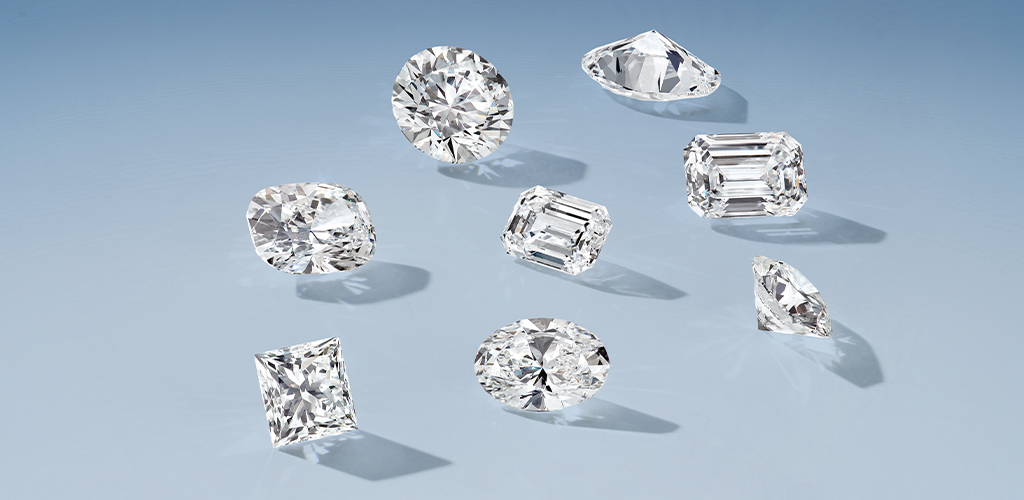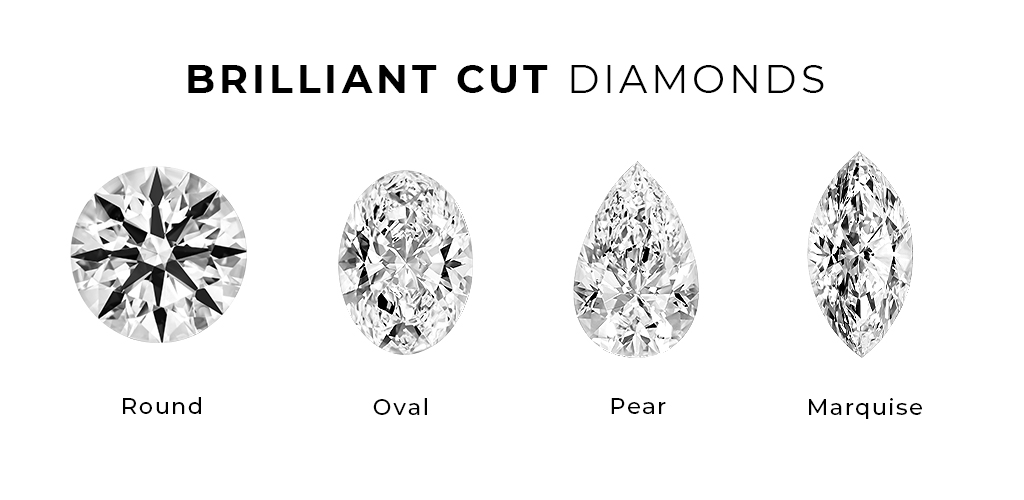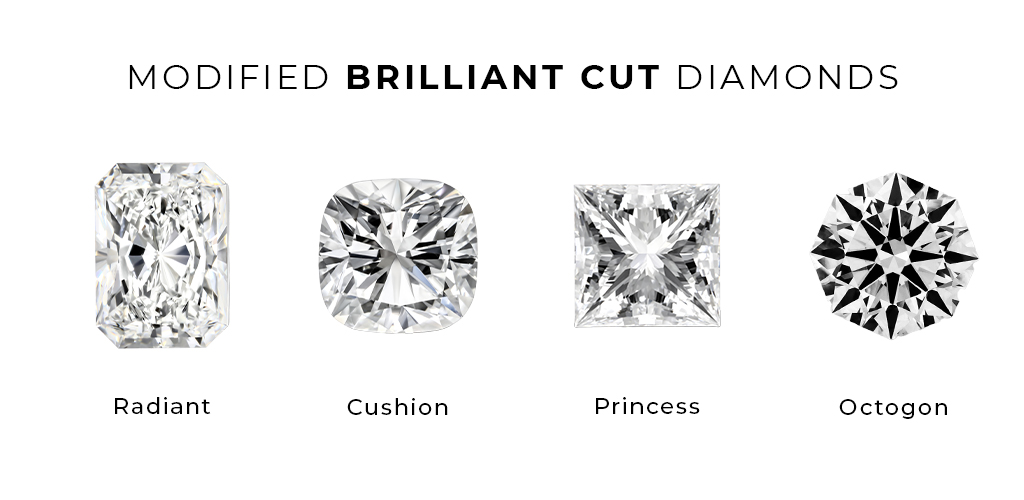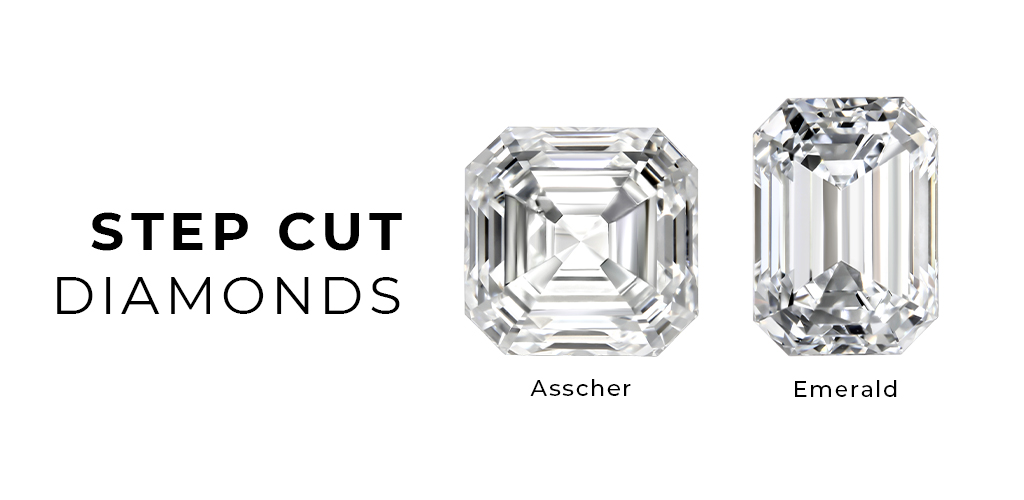
When it comes to diamonds, the shape you choose speaks volumes. It’s more than just aesthetics — your diamond’s shape can reflect your personality and style. If you’re on the hunt for a diamond, whether it’s for an engagement ring, a necklace, or a little treat-yourself moment (because why not?), this guide will help you navigate the glittering world of diamond shapes.
From classics to modern cuts, let’s explore the most popular diamond shapes, their unique characteristics, and how to find the one that feels just right for you.
Understanding the shape of a diamond is important for any jewelry buyer since it influences the stone’s style, price, and overall appearance. When you shop for diamonds, you’ll encounter various shapes to choose from, each with its own unique attributes and aesthetic appeal.
From classic round diamonds to fancy shapes like oval, cushion, princess, pear, emerald, marquise, asscher, radiant, and heart-shaped diamonds. Each shape offers unique angles and facets that affect how light is captured and reflected, enhancing the diamond’s natural brilliance and character.

The shape of a diamond isn’t just about how it looks—it influences the stone’s sparkle, size perception, and even price. Shape refers to the diamond’s outline when viewed from above, and each cut interacts with light differently, creating a unique sparkle and character.
Whether you’re drawn to the fiery brilliance of a round diamond or the vintage charm of a cushion cut, understanding your options can make the buying process smoother and more fun.
The round brilliant diamond is the ultimate classic. Its timeless appeal comes from its unmatched brilliance, thanks to its 58 expertly cut facets that maximize light reflection. This is the most popular diamond shape and a favorite for engagement rings.
If you love tradition and drama (in a good way), the round brilliant is for you. Its versatility means it looks stunning in any setting, from classic solitaires to modern halos.
Pros:
Cons:
The oval cut diamond combines the brilliance of a round diamond with an elongated shape, creating a sleek, sophisticated look. It’s a top choice for those who want to stand out subtly.
Oval diamonds elongate fingers and create a stunning visual impact without being too showy. Their elongated shape can also make the stone look larger than its carat weight.
Pros:
Cons:
The marquise cut diamond has an elongated shape with pointed ends that maximizes carat weight, making it appear larger than it is. Its silhouette has a dramatic, vintage feel that commands attention.
This shape is ideal for those who love bold designs and want their diamond to make a statement. It’s also perfect for elongating fingers and creating a unique, eye-catching look.
Pros:
Cons:
The pear shaped diamond, also known as a teardrop, combines the best of round and marquise shapes. Its distinctive silhouette is both elegant and playful.
This shape is for those who embrace individuality. It’s often chosen by people who want a diamond that stands out in a sea of traditional cuts.
Pros:
Cons:

The princess cut diamond is a square-shaped diamond that combines contemporary style with brilliant sparkle. Its sharp corners and angular silhouette give it a bold and modern feel.
This cut is perfect for those who love clean lines and a fresh, edgy look. It offers a high level of brilliance, rivaling the round brilliant, while showcasing a contemporary aesthetic.
Pros:
Cons:
The heart shaped diamond is one of the most distinctive cuts, representing romance and sentimentality. Its design requires precise craftsmanship to ensure symmetry and brilliance.
This shape is perfect for those who want their diamond to stand out while carrying a deeply personal meaning. It’s often chosen for romantic occasions like anniversaries or as a bold statement in engagement rings.
Pros:
Cons:
Radiant cut diamonds blend the rectangular or square shape of an emerald cut with the brilliance of a round cut. Its sparkling facets create an extraordinary light display, ideal for someone who wants the best of both worlds.
This cut is perfect for those who love a glamorous and vibrant look. It’s often chosen by individuals who want a diamond with maximum sparkle and a bold personality.
Pros:
Cons:
The octagon cut diamond is a bold choice, showcasing straight edges and clean lines with a hint of geometric flair. This unique cut highlights a modern yet architectural aesthetic.
This cut is perfect for trendsetters who appreciate striking designs and aren’t afraid to step outside the box. Its geometric feature makes it stand out from more common cuts.
Pros:
Cons:
The cushion cut diamond combines a square or rectangular shape with rounded edges, resembling a pillow, hence the name. Its timeless, soft appearance makes it a popular choice for those seeking a blend of vintage and modern appeal.
Cushion cut diamonds are worn by romantics and lovers of tradition. Its delicate design appeals to those who love softer jewelry designs.
Pros:
Cons:

The emerald cut diamond features a rectangular shape with step cuts, creating a mesmerizing hall-of-mirrors effect. This shape is less about sparkle and more about clarity and elegance.
Emerald cuts are perfect for those who value understated sophistication. They showcase the diamond’s clarity like no other shape, making them ideal for minimalistic designs.
Pros:
Cons:
The Asscher cut diamond is a square diamond with step-cut facets, similar to the emerald cut but with a unique vintage flair. First developed in the early 1900s during the Art Deco era, it has a striking geometric symmetry and a hall-of-mirrors effect that makes it truly captivating.
This cut is ideal for those who appreciate vintage aesthetics and understated elegance. Its clean lines and subtle brilliance exude sophistication, making it perfect for those who value clarity and structure over intense sparkle.
Pros:
Cons:
The baguette cut is a rectangular shape with step cuts, offering a sophisticated, minimalist look. Often used as accent stones in settings, baguettes exude subtle elegance rather than flashy brilliance.
The baguette cut is ideal for those who appreciate clean lines and understated beauty. It’s often paired with larger center stones or used in eternity bands for its refined, architectural appeal.
Pros:
Cons:

Shopping for a diamond can feel overwhelming, but with a little knowledge and preparation, you’ll be confident in your choice. Follow these tips to make the process smooth and enjoyable:
Diamonds come in all shapes, sizes, and prices. Knowing your budget upfront helps you narrow your options and avoid overspending.
The 4Cs—cut, color, clarity, and carat weight—are the foundation of diamond quality. Here’s what to keep in mind:
Cut: This affects sparkle the most. Always prioritize a well-cut diamond.
Color: Choose near-colorless diamonds (G–H grade) for great value.
Clarity: Opt for eye-clean diamonds where inclusions are invisible to the naked eye.
Carat Weight: Bigger isn’t always better—look for balance between size and quality.
Every shape has its own personality. Think about what matches your style or the preferences of the person wearing it.
The setting is just as important as the diamond itself. Certain shapes, like marquise or pear, benefit from protective settings, while solitaires let the diamond take center stage.
Ensure the diamond comes with a grading report from a reputable lab, such as GIA (Gemological Institute of America) or AGS (American Gem Society).
Diamonds are durable but not indestructible. Make sure to ask about maintenance and cleaning tips for your chosen shape.
7. Lab Grown Vs. Natural
Know that you have the option between a lab grwn diamond and natural diamonds. Exploring both and comparing them to your preferences and budget is always recommended.
At the end of the day, the best diamond shape is the one that makes your heart skip a beat. Think about your lifestyle, personal style, and what matters most to you.
There’s really no wrong choice. The perfect diamond is the one that feels like it was made for you — or the person you’re gifting it to.
Now that you’re armed with all the diamond-savvy knowledge, it’s time to start your diamond buying journey. Happy shopping!
There are a plethora of benefits to buying loose diamonds online and it will almost always be the cheapest option. At James Allen you can inspect your diamond with a diamond and jewelry expert in real time, allowing them to help you make the best choice.
The most popular diamond size chosen for engagement rings is a 1.0 carat center stone. However, couples can opt for both smaller and larger diamonds. Another great and more affordable option at James Allen is lab created diamonds. Lab created diamonds are the next generation of diamonds that give you the benefit of purchasing a larger size diamond at a more affordable price.
Generally, the shape of the diamond won’t affect its quality, however the way a diamond is cut may impact the diamond’s beauty, brilliance and value.
There are several ways to tell. Some of them require an expert eye to identify imperfections. Ironically, imperfections indicate pure diamonds. The easiest way to tell if a diamond is real or fake is to drop it in a glass of water. Real diamonds will sink toward the bottom while fake diamonds will float around the middle or top.
Conflict free diamonds refer to diamonds that have been carefully selected for their ethical and environmentally responsible origins.